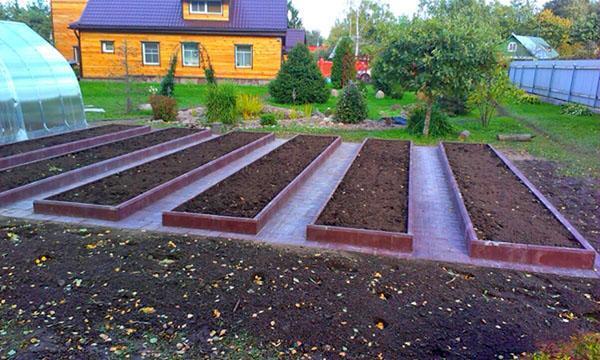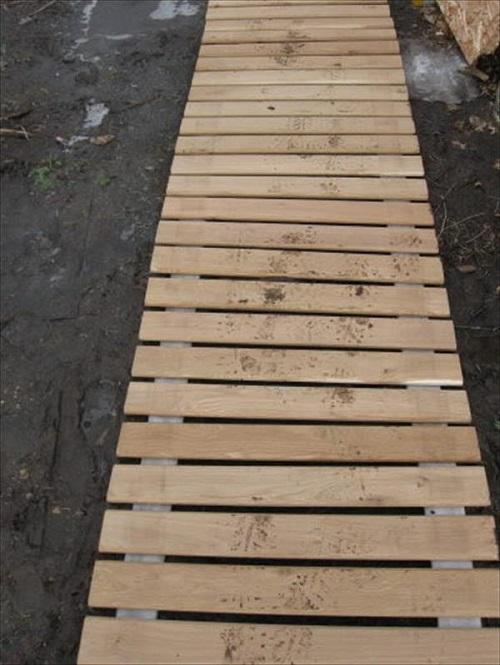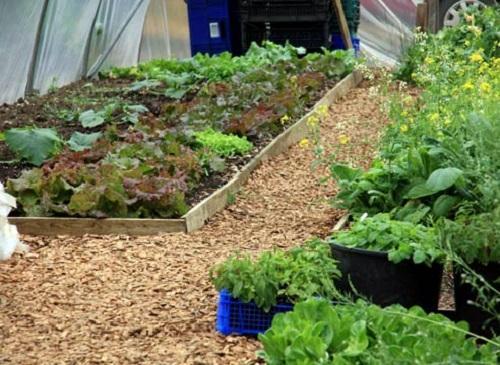Paths in the garden between the beds: what to make of
The vegetable garden is a place where summer residents spend most of the year, from spring to late autumn. There is always enough work on it: here and planting, and watering, and harvesting, and the eternal struggle with weeds. Naturally, every gardener wants to ease the chores of the garden at least a little and make the stay in the beds more comfortable. An important role in this is played by the paths between the groups of planted crops, along which gardeners walk during their processing.
 This issue is especially relevant after the rains, when weeds climb from all sides. In dry weather, you can still move between the beds during weeding, but after the soil becomes limp, many simply wait until everything dries out. And at this time, the garden is overgrown with weeds.
This issue is especially relevant after the rains, when weeds climb from all sides. In dry weather, you can still move between the beds during weeding, but after the soil becomes limp, many simply wait until everything dries out. And at this time, the garden is overgrown with weeds.
What are tracks for?
Having shown imagination in arranging the paths, you can give the site an original look. But it's not just about beauty, because the presence of equipped passages will allow:
- weeding even after heavy rains;
- calmly move around the garden, without getting your feet dirty.
Thanks to the paths, the cultivated area of the site, where weeds grow, is reduced.
Recommendations for arranging tracks
Before proceeding with the formation of the passages, it is worth considering some factors that will help make the paths not only beautiful, but also practical:
- all paths should be made straight, without convolutions, and as close to the beds as possible;
- two or three main roads with a width of up to 60 cm are enough for a wheelbarrow to pass. The rest of the paths are about 30 cm wide - this is enough for the passage.
Track material
What is the best way to make paths in the garden between the beds? There are many options for choosing a material, and almost all of them have both positive and negative sides:
- Wood. A wide board is laid out between the rows or flooring is made. The tree can be used for temporary and portable tracks. But if you put it on stationary passages, it will soon rot. In addition, snails and slugs gather under the damp planks.

- Mulch (sawdust, hay, straw, grass). Covering paths with hay, grass, or straw mulch can contain weeds and fertilize the soil. However, when laying fresh sawdust between the beds, there is a risk of soil oxidation.

- Siderata... The advantage of this path is that mustard, rapeseed or oats serve as fertilizer. But walking on them is not very convenient, moreover, you need to mow regularly.

- Crushed stone, pebbles, bricks. One of the best options for arranging paths, provided that they are stationary. Crushed stone and pebbles are usually just covered up. A whole brick can be simply laid tightly, and a cemented path is poured from the broken fragments. The edges of the track should be fixed with bumpers so that it does not creep.

- Concrete paths - the most practical option for permanent aisles between the beds. They are easy to care for, and the weeds will never appear there.

- The tracks laid out from tree cuts or individual stones, they are also called stepping stones. It is convenient to move along them, and if necessary, you can move to a new place.

A vegetable garden with beds is very convenient, but over time, the paths are overgrown and you have to dig up.
The old linoleum was laid.
The lower layer is coal slag or fine coal, medium ASG, upper fine crushed stone, fraction 15-20 mm. As a result, the grass does not germinate, the water quickly goes into the ground. And there is no mud in the rain.
We cut old carpets and rugs to the size of the paths, and in some places and linoleum, especially where there is more grass. For the winter, we hung the rugs in the shed and now we will lay them down again.
I dug grooves in the size of the path, filled in the ASM, cement mortar on top, porcelain stoneware tiles ... the path along the width of the tiles .. convenient, beautiful, practical ... I can send a photo